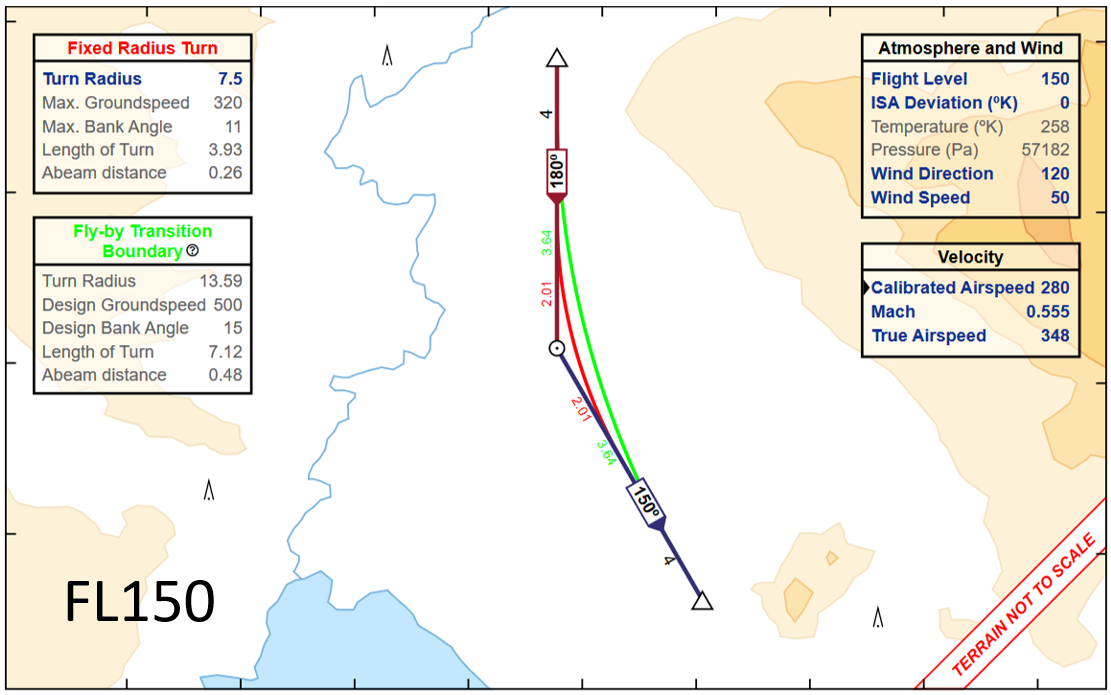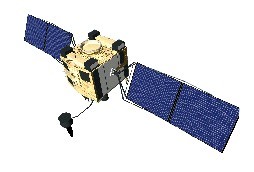The start of a turn depends on the waypoint transition. The most common type of turn performance is 'Fly By'. This type of turn results in the aircraft initiating the turn at some point prior to the waypoint (maximum of 20NM) and the computer commanding a fixed angle of bank (AOB) to allow tangential interception of the next segment of a route or procedure. Turn initiation will vary between aircraft. See here for further information.
Below is a set of example turns generated using the Turn Calculator showing the earliest possible Fly By turn (in Green) as defined by the industry standards (DO 236C/ED75D) and the Fixed Radius Transition (in Red) where a required radius for the turn is coded into the airways record. The green curve denotes the earliest path that the aircraft would follow, and the area between the green path and the black lines is known as the 'Transition Area'. Aircraft on Fly By transitions will fly a curved path somewhere within this area.



30° Turn



45° Turn



60° Turn
ATCOs are required to be familiar with contingency procedures developed by their Units. These procedures can cater for a variety of abnormal situations, which should today, also make provision for contingency measures to cater for cases when GPS is unusable.
Some ATCO units provide a panel indication of the status of ground-based NAVAIDS. A RED light indicates unusable and GREEN indicates usable. Therefore, if a particular VOR is unserviceable, it would show a red light, and the controllers would know not to issue any clearance that relied on the use of that specific NAVAID. As the number of conventional SIDS/STARS have increased to over a 100 at some major airports, the situation has become more complex.
 With PBN, the controller also needs to know the status of GNSS and whether it is usable and if not what the scale and duration of the outage period. This information may reach the controller either through NOTAM, pilot reports or possibly, if advantage is taken of airborne equipment such as ADS-B, the loss of the ADS-B information is integrated into information that is usable by ATC; any such technological solution would require development.
With PBN, the controller also needs to know the status of GNSS and whether it is usable and if not what the scale and duration of the outage period. This information may reach the controller either through NOTAM, pilot reports or possibly, if advantage is taken of airborne equipment such as ADS-B, the loss of the ADS-B information is integrated into information that is usable by ATC; any such technological solution would require development.
When information that the GPS is unusable is available, the controller should inform the pilot who would then decide how to conduct the operation as an alternative and if it is an approach, whether or not diversion to another aerodrome is required. Ideally, the supervisory chain should be provided with information on GPS outage and, when appropriate, decide that the GPS is unusable for operations in a given volume of airspace. Such information should be disseminated to working positions. Appropriate contingency procedures should be in place for such occurrences. When the GPS is unusable, the ATCO should not:
- Clear an aircraft for an RNP APCH: All RNP APCH require GPS. However, if EGNOS is not working the pilot should know that the aircraft cannot fly an RNP APCH to LPV minima.
- Clear an aircraft for a procedure that is authorised using GPS position only: Here the reference is to PBN SID/STAR, ATS or free routes which have been published/predicated only on GPS, either because there is no available ground-based infrastructure to support the PBN operation or because the use of available DMEs is not suitable.
- Clear a GPS only equipped aircraft for a procedure that is authorised using GPS or DME position: This is only possible if the ATCO is provided with accurate equipage information extracted from Items 10 and 18 of the filed ICAO flight plan and its associated update messages.
For further information on GNSS outage and contingency planning, refer to the European GNSS Contingency/Reversion Handbook for PBN Operations (Handbook 6) which can be found here.